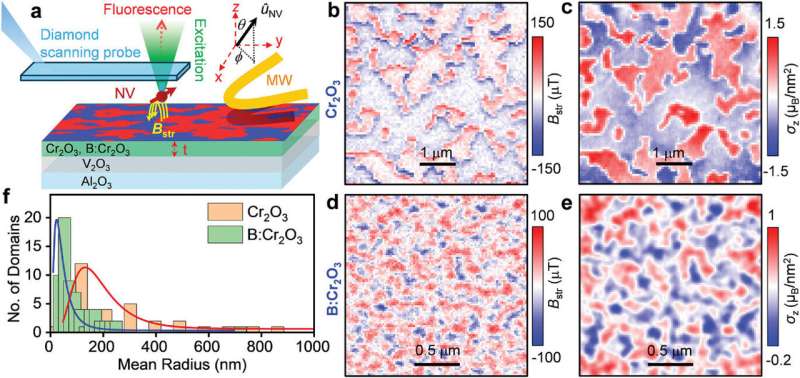
September 18, 2024 by Dan Moser, University of Nebraska-Lincoln
Collected at: https://phys.org/news/2024-09-antiferromagnetic-spintronics-advance-door-gen.html
University of Nebraska–Lincoln researchers have achieved a breakthrough in antiferromagnetic spintronics, a development that could expand the nanotechnology’s capabilities, which have been limited by their need for excessive power.
The team has been able to show that introducing boron—a process called B-doping—into magnetoelectric oxides can control magnetic fields at the high temperatures prevalent in electronics. This has long been the “holy grail” of such research, said Christian Binek, Charles Bessey Professor of physics.
The study is published in the journal Advanced Functional Materials.
Many remarkable discoveries in spintronics—the driving technology behind next-generation nano-electronic devices—have occurred in the last three decades, but one of the key obstacles to maximizing these devices’ potential was finding a quantum material whose magnetic states could be altered by electronic means alone, and in above-room temperature conditions.
The material the Nebraska team is studying—chromium oxide with a dash of boron—could help herald the emergence of digital memory and processors that consume far less power, while potentially running even faster, than their modern-day counterparts.
Chromium oxide exhibits a phenomenon called antiferromagnetism, which features alternating columns of atoms whose poles point in opposite directions and effectively cancel each other out, yielding virtually no magnetic field.
Previously, chromium oxide permitted voltage control of the antiferromagnetic order, but it was limited because it did not work at high temperatures and required a symmetry-breaking applied magnetic field.

Another member of the research team, Abdelghani Laraoui, assistant professor of mechanical and materials engineering, devised a means to study and confirm the efficacy of the boron-doping approach—nitrogen vacancy scanning probe microscopy.
With NV microscopy, researchers can directly image the boundary magnetization and see the effects of the B-doping, Laraoui said. This was demonstrated earlier in another collaborative work between Laraoui and Binek, published in 2022 in RSC Advances.
Laraoui’s unique NV imaging platform confirms the effects researchers previously could only theorize, said Binek, scientific director of the Emergent Quantum Materials and Technologies collaboration, or EQUATE, that is conducting this research. Laraoui leads the EQUATE research group focused on quantum technologies.
More information: Adam Erickson et al, Imaging Local Effects of Voltage and Boron Doping on Spin Reversal in Antiferromagnetic Magnetoelectric Cr2O3 Thin Films and Devices, Advanced Functional Materials (2024). DOI: 10.1002/adfm.202408542
Journal information: Advanced Functional Materials , RSC Advances

Leave a Reply